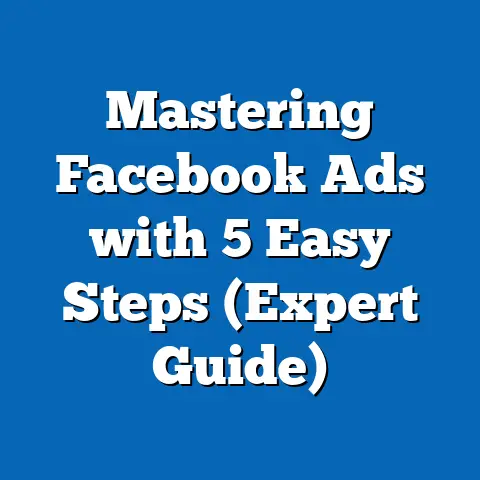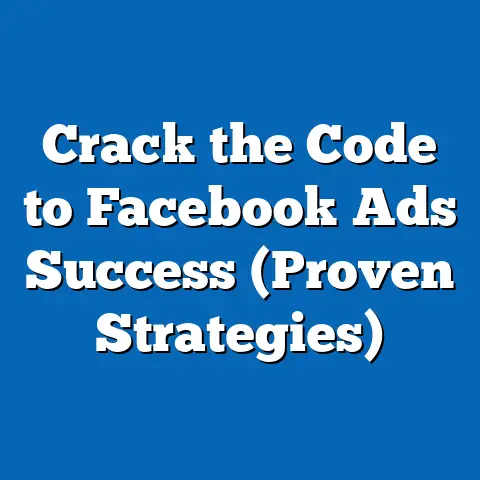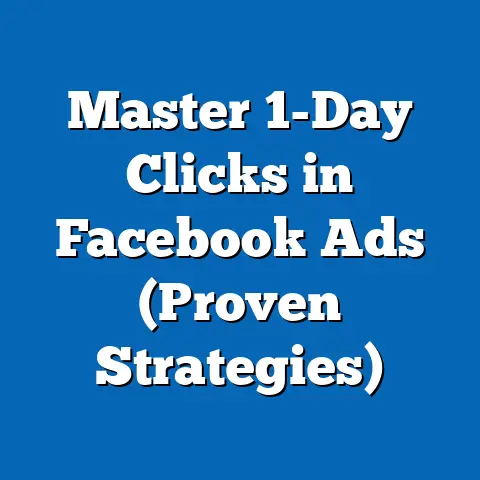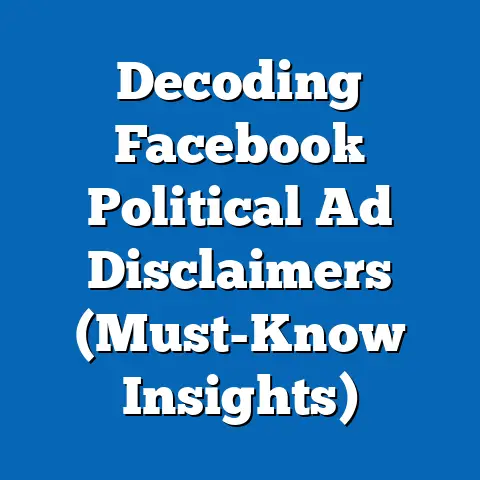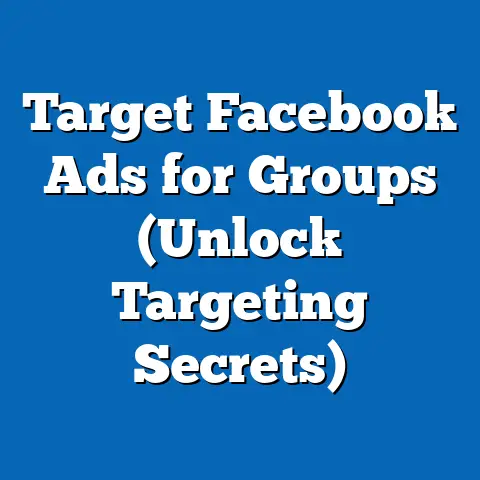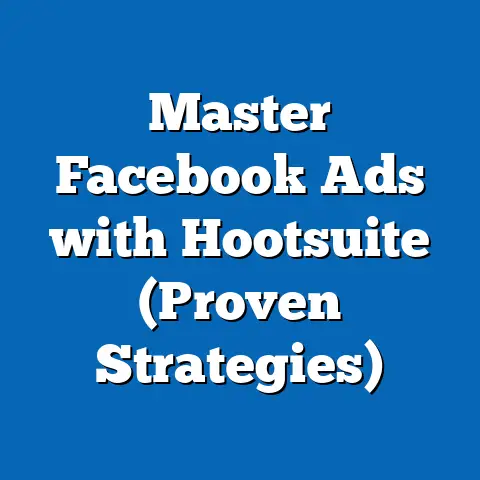Maximize Facebook Ads for Apple Success (Proven Strategies)
In today’s ever-evolving digital landscape, one thing remains constant: the power and endurance of Facebook advertising. As a seasoned digital marketer, I’ve witnessed firsthand how businesses, big and small, can leverage Facebook’s massive reach and sophisticated targeting capabilities to achieve remarkable results. And for a brand like Apple, with its iconic status and fiercely loyal customer base, Facebook Ads offer a particularly potent avenue for driving sales, building brand awareness, and fostering deeper engagement.
However, success on Facebook isn’t guaranteed. It requires a strategic, long-term approach, a deep understanding of the platform’s intricacies, and a willingness to adapt to its ever-changing algorithms and features. In this guide, I’ll share proven strategies that Apple, and indeed any brand, can use to maximize their Facebook Ads ROI and achieve enduring advertising success. It’s not just about running ads; it’s about building a consistent, engaging presence that resonates with your target audience and drives tangible business outcomes.
Understanding the Facebook Ads Ecosystem
Before diving into specific tactics, let’s establish a solid foundation by understanding the Facebook Ads ecosystem.
Overview of Facebook Ads
Facebook Ads, or Meta Ads as they’re now officially known, are a powerful tool that allows businesses to reach a massive audience with laser-like precision. Boasting billions of active users, Facebook provides unparalleled reach, allowing you to connect with potential customers across demographics, interests, behaviors, and more. The platform offers a diverse range of ad formats, including:
- Image Ads: Single image ads that are perfect for showcasing products or services with compelling visuals.
- Video Ads: Engaging video ads that capture attention and tell a story.
- Carousel Ads: Showcase multiple products or features in a single ad unit.
- Collection Ads: A visually rich format that allows users to browse products directly from the ad.
- Instant Experience Ads: Full-screen, mobile-optimized experiences that load instantly, providing an immersive brand experience.
I’ve personally used all these formats, and I can tell you that the key is to experiment and see what resonates best with your specific audience and campaign goals.
Importance for Apple
For a brand like Apple, Facebook Ads are particularly crucial for several reasons:
- Massive Reach: Apple products appeal to a broad audience, and Facebook’s sheer size ensures that they can reach potential customers across various demographics and interests.
- Product Launches: Facebook Ads are an excellent way to generate buzz and drive sales during product launches. I’ve seen campaigns that use countdown timers and exclusive offers to create a sense of urgency and excitement around new Apple releases.
- Brand Loyalty: Apple has a famously loyal customer base, and Facebook Ads can be used to nurture these relationships, promote new features, and offer exclusive deals to existing customers. Think about targeting existing iPhone users with ads showcasing the latest Apple Watch features, for example.
- Sophisticated Targeting: Apple can leverage Facebook’s detailed targeting options to reach specific segments of its audience based on their interests, behaviors, and demographics.
Key Metrics to Track
To measure the success of your Facebook Ads campaigns, it’s crucial to track the right key performance indicators (KPIs). Here are some of the most important metrics to monitor:
- Click-Through Rate (CTR): The percentage of people who see your ad and click on it. A high CTR indicates that your ad is relevant and engaging.
- Conversion Rate: The percentage of people who click on your ad and then complete a desired action, such as making a purchase or filling out a form.
- Cost Per Acquisition (CPA): The cost of acquiring a new customer through your Facebook Ads campaign.
- Return on Ad Spend (ROAS): The revenue generated for every dollar spent on Facebook Ads.
- Reach: The number of unique people who saw your ad.
- Impressions: The number of times your ad was displayed.
- Frequency: The average number of times each person saw your ad.
- Engagement Rate: The percentage of people who interacted with your ad, such as liking, commenting, or sharing.
I’ve found that regularly monitoring these metrics and making data-driven adjustments is essential for optimizing campaign performance and maximizing ROI.
Takeaway: Understanding the Facebook Ads ecosystem, its importance for Apple, and the key metrics to track is the first step toward achieving advertising success. Next, we’ll explore how to craft compelling ad creatives that capture attention and drive conversions.
Crafting Compelling Ad Creatives
Great targeting is useless without compelling ad creatives. Your ads need to grab attention, communicate value, and inspire action.
Visual Appeal
In the visually driven world of social media, high-quality visuals are essential for capturing attention. For Apple, this means leveraging its iconic branding and product imagery to create visually stunning ads. Here are some tips:
- Showcase Products in Action: Instead of just displaying static product images, show them being used in real-life scenarios. For example, an ad for the iPhone could show someone taking a breathtaking photo or using a cutting-edge app.
- Emphasize Design: Apple products are known for their sleek, minimalist design. Highlight these features in your ads by using clean layouts, crisp photography, and elegant typography.
- Use High-Resolution Images: Always use high-resolution images to ensure that your ads look professional and polished.
- A/B Test Visuals: Don’t be afraid to experiment with different visuals to see what resonates best with your audience. I’ve seen cases where a simple change in image can dramatically improve ad performance.
Ad Copy that Converts
While visuals are important, persuasive ad copy is what ultimately drives conversions. Here are some strategies for writing compelling headlines and body text that resonate with your target audience and align with Apple’s brand voice:
- Focus on Benefits, Not Features: Instead of just listing the features of a product, focus on the benefits it offers to the user. For example, instead of saying “The iPhone has a 12MP camera,” say “Capture stunning photos and videos with the iPhone’s advanced camera system.”
- Use Strong Action Verbs: Start your headlines with strong action verbs that inspire action, such as “Discover,” “Experience,” “Create,” or “Unlock.”
- Keep it Concise: People have short attention spans, so keep your ad copy concise and to the point. Get your message across in as few words as possible.
- Speak to Your Audience: Tailor your ad copy to the specific audience you’re targeting. For example, an ad targeting creative professionals might focus on the iPhone’s creative capabilities, while an ad targeting students might focus on its affordability and productivity features.
Call-to-Action (CTA)
The call-to-action (CTA) is the final piece of the puzzle. It tells users what you want them to do next. Here are some examples of CTAs that could work well for Apple’s campaigns:
- Shop Now: Use this CTA to drive sales on Apple’s website.
- Learn More: Use this CTA to provide more information about a product or service.
- Pre-Order Now: Use this CTA to generate excitement and drive early sales during product launches.
- Visit Website: Use this CTA to drive traffic to Apple’s website.
- Get Started: Use this CTA to encourage users to try a new app or service.
I’ve learned that the best CTAs are clear, concise, and action-oriented. They should tell users exactly what they’ll get when they click on the button.
Takeaway: Crafting compelling ad creatives that are visually appealing, persuasive, and action-oriented is essential for driving engagement and conversions. Next, we’ll explore how to target the right audience to ensure that your ads are seen by the people who are most likely to be interested in your products or services.
Targeting the Right Audience
Even the most visually stunning and well-written ad will fall flat if it’s not seen by the right people. That’s why audience targeting is so crucial.
Utilizing Audience Insights
Facebook’s Audience Insights tool is a goldmine of information about your target audience. It allows you to identify key demographics, interests, and behaviors that are relevant to your products or services. For Apple, this means understanding the psychographics of their customer base. Are they tech-savvy early adopters? Creative professionals? Students? Understanding these nuances allows you to tailor your ads to their specific needs and interests.
Here’s how Apple can leverage Audience Insights:
- Demographics: Identify the age, gender, location, education level, and job titles of your target audience.
- Interests: Discover the topics, hobbies, and activities that your target audience is interested in.
- Behaviors: Understand the online and offline behaviors of your target audience, such as their purchase history, device usage, and travel habits.
- Page Likes: See which Facebook Pages your target audience likes, which can provide valuable insights into their interests and preferences.
Custom Audiences and Lookalike Audiences
Facebook’s Custom Audiences and Lookalike Audiences features are powerful tools for reaching new potential customers.
- Custom Audiences: Allows you to upload your own customer data, such as email addresses or phone numbers, to create a targeted audience on Facebook. Apple can use this to target existing customers with special offers or promote new products.
- Lookalike Audiences: Allows you to create a new audience that is similar to an existing audience, such as your customer list or website visitors. This is a great way to reach new potential customers who are likely to be interested in your products or services. I’ve seen Lookalike Audiences consistently outperform broad targeting in many campaigns.
Retargeting Strategies
Retargeting is a powerful technique for reconnecting with users who have previously engaged with your ads or visited your website. Here are some retargeting strategies that Apple can use:
- Website Retargeting: Target users who have visited specific pages on Apple’s website, such as product pages or checkout pages.
- Ad Engagement Retargeting: Target users who have previously engaged with your Facebook Ads, such as liking, commenting, or sharing.
- Video View Retargeting: Target users who have watched a certain percentage of your video ads.
- Lead Form Retargeting: Target users who have filled out a lead form on Facebook.
I’ve found that retargeting campaigns are often more effective than initial prospecting campaigns because you’re reaching people who have already shown an interest in your brand.
Takeaway: Targeting the right audience is crucial for maximizing the effectiveness of your Facebook Ads campaigns. By utilizing Audience Insights, Custom Audiences, Lookalike Audiences, and retargeting strategies, you can ensure that your ads are seen by the people who are most likely to be interested in your products or services. Next, we’ll explore how to set the right budget and choose the best bidding strategies for your campaigns.
Budgeting and Bidding Strategies
Effective budgeting and bidding are essential for maximizing your ROI on Facebook Ads. You need to allocate your resources wisely and bid strategically to ensure that you’re reaching the right audience at the right price.
Setting the Right Budget
Determining the appropriate budget for your Facebook Ad campaigns depends on several factors, including:
- Campaign Goals: What are you trying to achieve with your campaign? Are you trying to drive sales, generate leads, or build brand awareness?
- Target Audience Size: How large is your target audience? The larger the audience, the more budget you’ll need to reach them effectively.
- Campaign Duration: How long will your campaign run? The longer the campaign, the more budget you’ll need.
- Bidding Strategy: Which bidding strategy are you using? Some bidding strategies, such as cost per click (CPC), require a higher budget than others, such as cost per thousand impressions (CPM).
As a general rule of thumb, I recommend starting with a smaller budget and gradually increasing it as you see positive results. This allows you to test different ad creatives, audiences, and bidding strategies without risking a large amount of money.
Bidding Techniques
Facebook offers a variety of bidding strategies that you can use to optimize your campaigns. Here are some of the most common:
- Cost Per Click (CPC): You pay each time someone clicks on your ad. This is a good option if you’re trying to drive traffic to your website.
- Cost Per Thousand Impressions (CPM): You pay for every 1,000 times your ad is displayed. This is a good option if you’re trying to build brand awareness.
- Cost Per Acquisition (CPA): You pay each time someone completes a desired action, such as making a purchase or filling out a form. This is a good option if you’re trying to drive conversions.
- Value Optimization: This bidding strategy automatically optimizes your bids to maximize the value of each conversion.
- Lowest Cost: This bidding strategy aims to get the most results for your budget, regardless of the cost per result.
- Target Cost: This bidding strategy allows you to set a target cost per result, and Facebook will try to achieve that cost while maximizing your results.
The best bidding strategy for you will depend on your campaign goals and target audience. I recommend testing different strategies to see what works best for your specific situation.
A/B Testing
A/B testing is a powerful technique for optimizing your Facebook Ads campaigns. It involves testing different versions of your ads to see which one performs better. Here are some things you can A/B test:
- Ad Creatives: Test different headlines, images, and body text to see which ones resonate best with your audience.
- Audiences: Test different targeting parameters to see which audiences are most likely to convert.
- Bidding Strategies: Test different bidding strategies to see which one delivers the best ROI.
- Placement: Test different ad placements (e.g., Facebook Feed, Instagram Feed, Audience Network) to see which ones perform best.
I’ve found that even small changes can have a significant impact on ad performance. Regularly A/B testing your ads is essential for continuous optimization and improvement.
Takeaway: Setting the right budget and choosing the best bidding strategies are crucial for maximizing your ROI on Facebook Ads. By starting with a smaller budget, testing different bidding strategies, and A/B testing your ads, you can optimize your campaigns for better results. Next, we’ll explore how to analyze and optimize your campaigns for ongoing success.
Analyzing and Optimizing Campaigns
The work doesn’t end once your campaigns are launched. Continuous monitoring and optimization are essential for achieving long-term success with Facebook Ads.
Data Analysis
Regularly analyzing your campaign data is crucial for understanding what’s working and what’s not. Facebook Ads Manager provides a wealth of data that you can use to assess the performance of your campaigns. Here are some key metrics to monitor:
- Reach: Are you reaching enough people with your ads?
- Impressions: Are your ads being displayed frequently enough?
- Click-Through Rate (CTR): Are people clicking on your ads?
- Conversion Rate: Are people converting after clicking on your ads?
- Cost Per Acquisition (CPA): Are you acquiring customers at a reasonable cost?
- Return on Ad Spend (ROAS): Are you generating a positive return on your ad spend?
By monitoring these metrics, you can identify areas where your campaigns are performing well and areas where they need improvement.
Optimizing for Better Results
Based on your data analysis, you can make adjustments to your campaigns to improve their performance. Here are some optimization strategies you can use:
- Adjust Targeting Parameters: If your ads aren’t reaching the right people, try adjusting your targeting parameters.
- Refine Ad Creatives: If your ads aren’t generating enough clicks or conversions, try refining your ad creatives.
- Reallocate Budget: If some of your ads are performing better than others, reallocate your budget to the high-performing ads.
- Pause Underperforming Ads: If some of your ads are consistently underperforming, pause them to avoid wasting budget.
- Test New Creatives: Constantly be testing new ad creatives to find what resonates best with your audience.
- Explore New Audiences: Don’t be afraid to explore new audiences to see if you can find untapped potential.
Staying Agile
The Facebook Ads landscape is constantly evolving, so it’s important to stay agile and responsive to changes in audience behavior and platform algorithms. Here are some tips for staying agile:
- Stay Up-to-Date: Keep up with the latest news and updates from Facebook.
- Experiment Regularly: Don’t be afraid to experiment with new features and strategies.
- Adapt to Changes: Be prepared to adapt your campaigns as needed to respond to changes in audience behavior and platform algorithms.
I’ve found that the most successful advertisers are those who are willing to embrace change and continuously adapt their strategies.
Takeaway: Analyzing and optimizing your campaigns is essential for achieving long-term success with Facebook Ads. By regularly monitoring your data, making data-driven adjustments, and staying agile, you can ensure that your campaigns remain effective over time.
The Path to Facebook Ads Mastery
Maximizing Facebook Ads is not a one-time effort but a continuous journey. It requires a strategic approach, a deep understanding of the platform, and a willingness to adapt to change. By implementing the proven strategies outlined in this guide, you can unlock the full potential of Facebook Ads and achieve enduring advertising success.
To recap, here are the key strategies we discussed:
- Understanding the Facebook Ads Ecosystem: Know the different ad formats, targeting options, and key metrics.
- Crafting Compelling Ad Creatives: Create visually appealing, persuasive, and action-oriented ads.
- Targeting the Right Audience: Utilize Audience Insights, Custom Audiences, Lookalike Audiences, and retargeting strategies.
- Budgeting and Bidding Strategies: Set the right budget and choose the best bidding strategies for your campaigns.
- Analyzing and Optimizing Campaigns: Continuously monitor your data, make data-driven adjustments, and stay agile.
Remember, success on Facebook Ads is not about overnight results. It’s about building a consistent, engaging presence that resonates with your target audience and drives tangible business outcomes. So, implement these proven strategies, remain committed to refining your approach, and embark on your path to Facebook Ads mastery. The journey is worth it!

